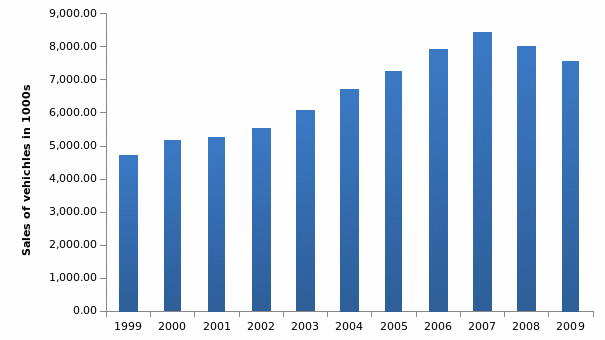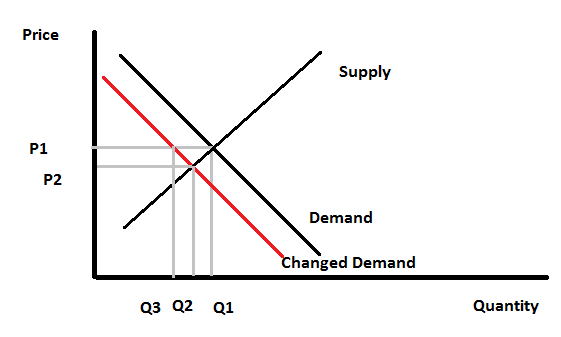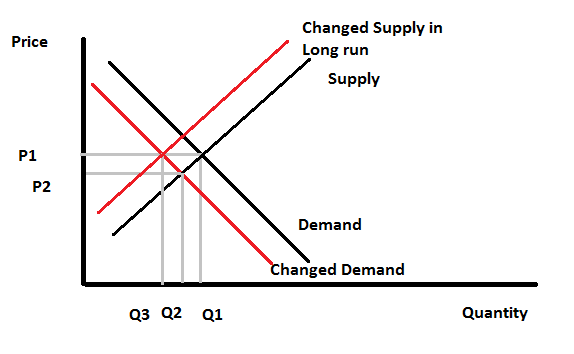Introduction
Toyota recalled 3.8 million vehicles from the US, European, and Chinese market in the third quarter of 2009 (Associated Press 2009). The recalled cars consisted of popular car models such as Camry and Prius (Associated Press 2009). The recall was staged due to technical issues found in the accelerator paddle of the cars manufactured and distributed. This recall evidently enforced a question on the minds of investors and analysts – if the demand for Toyota vehicles sustainable.
Thus, the question was if the demand for cars by Toyota would be affected by the recall of cars in 2009. In order to understand this problem facing Toyota, this essay will concentrate on the demand for Toyota cars in the short and long run and would try to indentify if there are any probable changes in the demand for automobiles by Toyota.
Toyota Car Recall – background
Toyota recalled a large number of its cars from the US, European, and Asian market due to faulty technicality in its vehicles. This affected a loss of sales by the company amounting to $2 million (Fisk 2010). According to the 2009 Annual Report of Toyota (2009) and the historical sales figures data (Toyota 2010), there has been a constant rise in the worldwide sales of vehicles by Toyota since 1999 through 2007, after which there has been a fall in the sales figures through 2009.
This indicates that there has been a fall in the demand for cars of Toyota in 2009. In 2008, quarterly revenue of Toyota has been increasing constantly. However, in 2009, the quarterly revenue of the automobile segment of the company decline. There has been a drop of overall revenue by 4.7 percent in first quarter of 2009, in second it was 7.9 percent. In third and fourth quarter, the decline was huge by 28.4 percent and 46.2 percent (Toyota 2009).

The annual report though blames the global recession as the main factor for the downfall in the revenue, the sales drop must be analysed in greater depth. The reason being, the drop in revenue was not that severe in the first and second quarter of 2009. Then why did the revenue drop by such exorbitant percent in the third and fourth quarter? Clearly, there has been a drop in sales figures in 2009.
Therefore, can it be assumed that even though by the end of 2009, the global economy had started to recover from recession, the sales of Toyota fell? Therefore, there must have been some other reason, which may have affected the decline in the sales of Toyota cars. Further as the production of the company exceeded the sales figures in 2009 (Toyota 2009), it can be safely assumed that sales fell due to decline in demand and not due to decline in supply of the products. In the next section, demand theory for consumer durables and automobiles is discussed.
Demand for Automobile Theory
The demand for automobiles is constrained by the consumer’s decision to own the vehicle. The decision to own a vehicle is not only determined by price, but also by a few socio-economic variables (Abu-Eisheh & Mannering 2002). Assuming the consumers to be utility maximizers and firms profit maximizers, it can be used to determine the demand and supply function in a market economy for a good. A number of factors may affect the demand for automobiles.
From a simple point of view, the demand for automobiles will depend on its price, level of macroeconomic activity like fiscal and monetary policy, etc, and price of complimentary (e.g. fuel prices) and substitute goods (Wetzel & Hoffer 1982). However, changes in consumer confidence may also affect the demand for consumer durables like automobiles (Garner 1991). This is so because the demand for consumer durable goods not only depends on present income and spending, but also on consumer uncertainty about the future economic condition or with consumer confidence with a particular product.
Therefore, if the consumer confidence worsens, demand for the consumer durable is expected to be reduced (Garner 1991). Therefore, when consumer confidence is low, consumers believe that the financial constraint that will befall on the consumer due to the present socio-economic condition, will affect their decision and reduce demand for the good. Thus, consumer confidence has a positive relation with the demand for consumer durables, when other things remain constant.
Consumer preference also affects consumer demand for automobiles (Wetzel & Hoffer 1982). Consumer preferences may change due to change in “non-price” market factors like styling or change in technology (Wetzel & Hoffer 1982). Therefore, the demand for goods will be dependent on the change in consumer preference. Therefore, demand function associated with changes in the consumer preference is found to be a positive relation. The basic demand function for automobiles can therefore depend of prices, income of consumer, prices of complementary and substitute goods, and consumer confidence and preference. The next section will show the short-run and long run demand for Toyota made cars.
Short-run Demand
Short-run demand for Toyota has been affected by the recall of the cars done by Toyota. Automobiles are consumer durables, and therefore the demand decision is dependent of the maximization of utility of the customers. This result in estimated overall benefit of buying a Toyota vehicle. As Toyota recalled the vehicles in early 2009, there has been a rising perception that this may happen in future. This future expectation of the company’s vehicle quality has affected the demand for cars. In case of Toyota, stock prices are taken as an indicator to determine the consumer preference for the customers and their confidence in the brand.
The stock prices of Toyota has been falling continuously since there has been recall of cars from the market by the company (Yahoo Finance 2010). This indicated that the confidence on Toyota has been dropping due to recall of cars, which created a perception of technical defects in Toyota cars.

Here we assume that 6 months is a short period. Therefore, as the news of vehicle recall spread, people get apprehensive about the quality of Toyota cars, especially Camri and Corolla, which were the most popular vehicles. Further, we assume that the changes in stock prices demonstrated the consumer confidence in the brand for the short-term period. Thus, the effect of changes in stock prices would indicate the elasticity of demand for Toyota cars when there is a change in consumer confidence.

Figure 3 shows that the stock prices for Toyota in the four quarters of 2009 increased in the first quarter, and then declined (Yahoo Finance 2010). Simultaneously, there ahs been a fall in sales with decline in stock prices of the company, indicating, that a lower confidence in the company has led to a lower demand for cars. Figure 3 shows that trend line of the scatter plot, indicating a strong positive relation between sales and stock prices. Indicating, in the short run, when there is a fall in consumer confidence in the company, there will be a fall in the demand for vehicles in the short run. Therefore, diagrammatically, with a decline in consumer confidence on Toyota, there will be a leftward shift in the demand curve (see figure 4).
As there is a change in the consumer confidence of the Toyota made cars, due to recall, there will be a fall in the demand. With prices remaining same, there will be a downward shift in the demand curve as is shown by the changed demand curve in red. With short run supply remaining same (as is shown in supply curve in the figure), the quantity demanded for the product will reduce from Q1 and Q2, and the price at which the customers are willing to buy the product will reduce from P1 to P2.

As in case of Toyota, there will be no price reduction done by the company to bring the market demand into equilibrium in short-run. This will make the price stick to P1 and the demand will reduce further to Q3. Thus, with a lowering of confidence of the consumer on a brand, there is expected to be a reduction in demand in the short-run.
In the short run there has been a fall in the car demand for Toyota as indicated by the NADA data (2010) there was decline in the sales of Toyota made cars like Camri and Corolla, while an increase was observed in car sales of other companies like Ford. This indicated, with a reduction in consumer confidence the customers refrained from buying cars from Toyota and switched to other carmakers. Thus, there was an increase in the US market share of carmakers like Hyundai, GM, Ford, and Nissan, while the share of Toyota declined in 2009 (NADA 2010). Therefore, in the short run, the recall of cars by Toyota had a negative effect on the demand for cars in the US, and is expected to have similar effect elsewhere.
Long-Run
In the long run, Toyota would try to regain and remake its image as a quality carmaker, gaining consumer confidence. This can be done through arrays of consumer propagandas and promotions. However, from the economic theory point of view, the demand for cars in the long run will regain.

Figure 5 shows the demand curve of the long run demand for Toyota cars. As demand for cars reduces in the short-run, the company will try to reduce its inventory by reducing the production of cars. This will reduce the supply of cars in the market. With a reduction in the production, and supply reduction, the supply curve will leftward. This would reduce the supply of cars to the market. As observed in figure 5, the supply curve shifts from the black to the red line in the left. Thus, with other conditions remaining same, the shift in supply curve will reduce the quantity sold from Q1 to Q3 at price P1. However, there has been a shift in the demand curve in the short-run.
Therefore, the new supply demand interaction occurs at price P1 and the quantity sold becomes Q3. As observed that the sales falls in the long run, however, prices remain same. Here the long run equilibrium will change over time, as there would be fall in demand for cars. However, at a very long period, the equilibrium and the demand curve will shift to the original position, as in the long run, no other factors that affect demand can remain constant, and therefore through a cyclical effect, it will change the demand such that it regains its original position.
Conclusion
Demand in shorter run is affected by the changes in consumer preference due to the shock of large amount of product recall by Toyota. Thus, there is a lowering of demand in short run. However, in long run, this situation may not persist. In the long run, the company has to aim at regain customer confidence and becoming the preferred automobile brand. The main problem faced by the car makers is not in the sale of new cars, rather is the sale of second hand cars, as prices of second hand cars also determine the purchase decision of a new car (Chandran 2010).
The reason for quality lapse as sited by the company is due to the rapid expansion of production capacity in order to meet high demand (Chandran 2010). Therefore, in longer run, as the production capacity will increase substantially due to the structural changes brought in the company, there will be higher capacity available to meet demand. This will help in meeting high demand without compromising on product quality.
Reference List
Abu-Eisheh, S.A. & Mannering, F.L., 2002. Forecasting Automobile Demand For Economies In Transition: A Dynamic Simultaneous equation System Approach. Transportation Planning and Technol, 25, p.311–331.
Associated Press, 2009. Toyota recalls 3.8 million vehicles. Web.
Chandran, V., 2010. Total Recall: Impact Assessment of Toyota’s Quality Issues on its North American Business. Web.
Fisk, M.C., 2010. Toyota Recall Cost Will Exceed $2 Bln, Lawyers Say. Web.
Garner, A., 1991. Forecasting Consumer Spending: Should Economists Pay Attention to Consumer Confidence Surveys? Economic Review, pp. 57-71.
NADA, 2010. National Automobile Dealers Association. Web.
Toyota, 2009. Annual Report. Web.
Toyota, 2010. Toyotal Databook. Web.
Wetzel, J. & Hoffer, G., 1982. Consumer Demand for Automobiles: A Disaggregated Market Approach. Journal of Consumer Research, 9, pp.195-99.
Yahoo Finance, 2010. Toyota Motor Corp (TM). Web.
